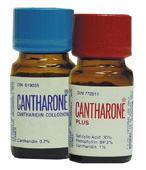Warts on the skin can be quite stubborn and often resistant to treatment. “In many cases, we use ‘destructive’ therapies on warts and other viral-induced skin lesions to literally blister up and peel these infections off the skin,” explains Dr. Adam Mamelak. “Cryotherapy with liquid nitrogen is one of the traditional therapies used by a dermatologist for these purposes, and although very effective, can be uncomfortable especially in kids and young children.”
 This is where Cantharidin comes in. Cantharidin is a chemical derived from the Blister Beetle. This insect’s secretion cause blistering in predators, and is used to protect its eggs. French Chemist Pierre Robiquet discovered this chemical, and its properties, in the early 1700’s. Since then, the use of Cantharidin has been perfected and is now a commonly used medical therapy in Dermatology practices. The application of this chemical causes a localized blister, which then peels off a few days later.
This is where Cantharidin comes in. Cantharidin is a chemical derived from the Blister Beetle. This insect’s secretion cause blistering in predators, and is used to protect its eggs. French Chemist Pierre Robiquet discovered this chemical, and its properties, in the early 1700’s. Since then, the use of Cantharidin has been perfected and is now a commonly used medical therapy in Dermatology practices. The application of this chemical causes a localized blister, which then peels off a few days later.
What is Cantharidin Used For?
There are several lesions and growths of the skin that can be treated with Cantharidin. “The most common use for this chemical treatment is for the removal of warts,” notes Dr. Adam Mamelak, a board certified Dermatologist in Austin, Texas. This treatment can also be used to remove bumps related to molluscum contagiosum.
How Does Cantharidin Work?
Cantharidin is a painless liquid blistering agent that is used to treat a variety of skin growths. It is applied directly to the wart, molluscum lesion, or affected area on the skin. The medication is typically washed off an hour or so after treatment and the skin is left to blister. In general, the blisters typically appear in about 24 hours after treatment. “The cantharidin causes cells to release an enzyme that breaks down proteins in desmosomal plaques, specific structures involved in cell-to-cell adhesion. That is, it breaks the bonds that hold skin cells together,” explains Dr. Mamelak. The resulting blister forces the wart or skin growth off of the skin.
This is a very effective treatment, but each patient’s reaction can be different. The chemical is known to be painless, although their can be irritation as the blistering occurs beneath the treated area. After the treated area heals there are minimal chances of scarring or marks left on the skin.
Are There Side Effects To This Treatment?
As with most medical treatments, there is the opportunity for adverse effects. This treatment tends to have quite mild side effects which rarely include skin tenderness, itching, or burning. Any break in the skin can also make one susceptible to an infection. Proper care of the treated site makes this extremely uncommon. If any symptoms persists for more than a couple of days after treatment, please contact your doctor.
Contact Us
Our goal at Sanova Dermatology is to assist you with any skin issues that you may have. If you have questions or concerns about your skin, please contact us and we can set up a consultation with our office.
Join Us
